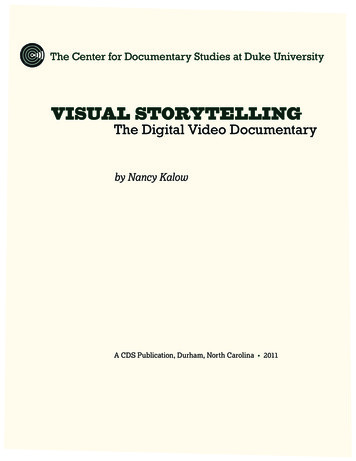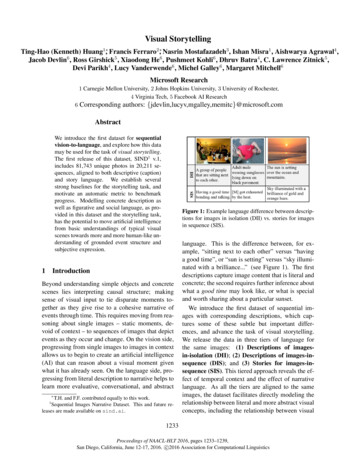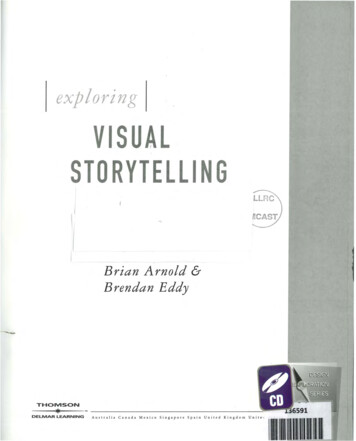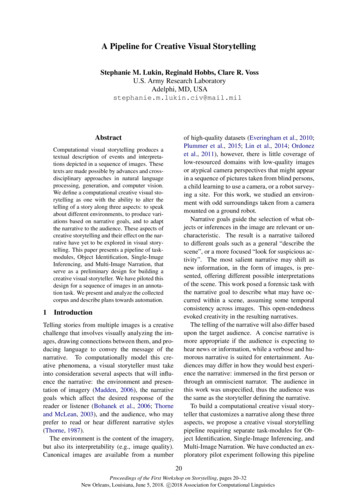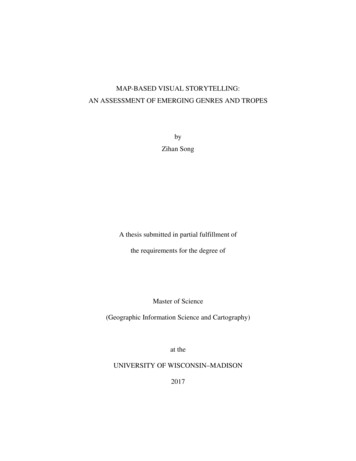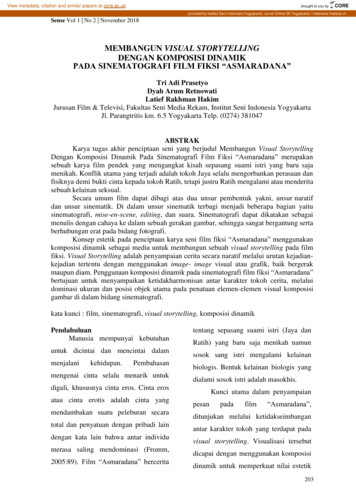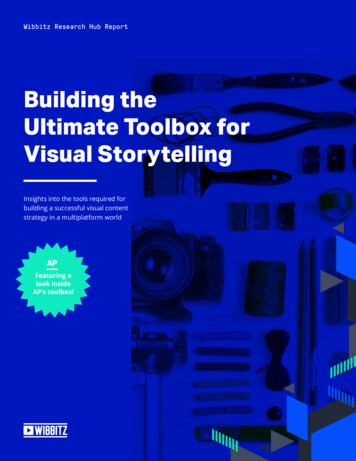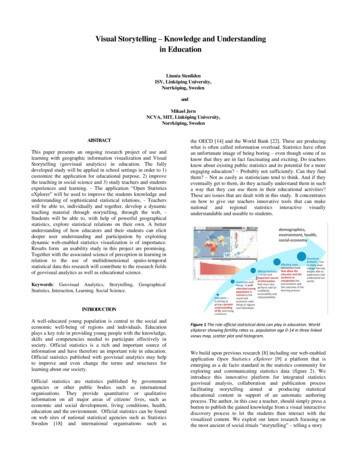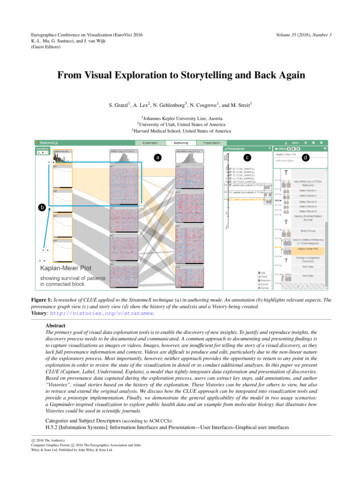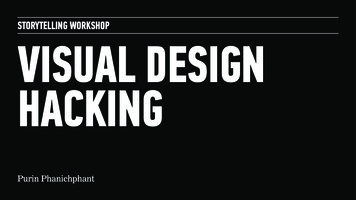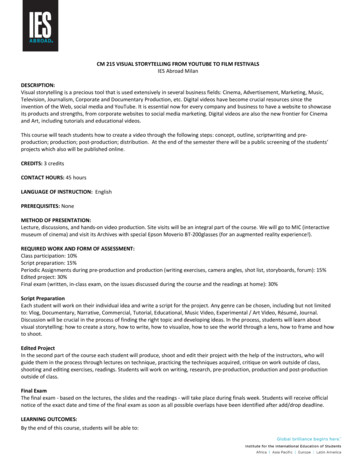
Transcription
CM 215 VISUAL STORYTELLING FROM YOUTUBE TO FILM FESTIVALSIES Abroad MilanDESCRIPTION:Visual storytelling is a precious tool that is used extensively in several business fields: Cinema, Advertisement, Marketing, Music,Television, Journalism, Corporate and Documentary Production, etc. Digital videos have become crucial resources since theinvention of the Web, social media and YouTube. It is essential now for every company and business to have a website to showcaseits products and strengths, from corporate websites to social media marketing. Digital videos are also the new frontier for Cinemaand Art, including tutorials and educational videos.This course will teach students how to create a video through the following steps: concept, outline, scriptwriting and preproduction; production; post-production; distribution. At the end of the semester there will be a public screening of the students’projects which also will be published online.CREDITS: 3 creditsCONTACT HOURS: 45 hoursLANGUAGE OF INSTRUCTION: EnglishPREREQUISITES: NoneMETHOD OF PRESENTATION:Lecture, discussions, and hands-on video production. Site visits will be an integral part of the course. We will go to MIC (interactivemuseum of cinema) and visit its Archives with special Epson Moverio BT-200glasses (for an augmented reality experience!).REQUIRED WORK AND FORM OF ASSESSMENT:Class participation: 10%Script preparation: 15%Periodic Assignments during pre-production and production (writing exercises, camera angles, shot list, storyboards, forum): 15%Edited project: 30%Final exam (written, in-class exam, on the issues discussed during the course and the readings at home): 30%Script PreparationEach student will work on their individual idea and write a script for the project. Any genre can be chosen, including but not limitedto: Vlog, Documentary, Narrative, Commercial, Tutorial, Educational, Music Video, Experimental / Art Video, Résumé, Journal.Discussion will be crucial in the process of finding the right topic and developing ideas. In the process, students will learn aboutvisual storytelling: how to create a story, how to write, how to visualize, how to see the world through a lens, how to frame and howto shoot.Edited ProjectIn the second part of the course each student will produce, shoot and edit their project with the help of the instructors, who willguide them in the process through lectures on technique, practicing the techniques acquired, critique on work outside of class,shooting and editing exercises, readings. Students will work on writing, research, pre-production, production and post-productionoutside of class.Final ExamThe final exam - based on the lectures, the slides and the readings - will take place during finals week. Students will receive officialnotice of the exact date and time of the final exam as soon as all possible overlaps have been identified after add/drop deadline.LEARNING OUTCOMES:By the end of this course, students will be able to:
Apply the concepts of visual storytelling by telling a story through images and sounds, from direction, to filming, to editing.Acquire the key skills of video making.Demonstrate competency in non-linear editing software.Use the terminology of storytelling, scriptwriting, video production and post-production competently.ATTENDANCE POLICY:Regular class attendance is mandatory. Students are expected to attend classes each day, including course-related excursions.IES Abroad Milano allows a maximum of two excused absences per semester. Each further absence will automatically result in apenalty of two points off (2/100) on the final grade. Seven absences per course (including 2 excused absences) will result in a failinggrade for that course. Furthermore, an absence on the date of scheduled tests, presentations or quizzes does not entitle you torecover/reschedule such tests. Failure to attend your midterm and/or final exam will result in an F grade on that paper/exam.CONTENT:LessonWeek 1Session 1ContentIntroduction.Proper Shooting Technique: camera operation andsound.Session 2Guidelines to visual storytelling.Clear Vision.Week 2Session 1The story triangle.Feedback on your first exercise on scriptwriting.AssignmentsPractice with the camera. First exercise on scriptwriting: location. From McKee’s textbook “Story”, chapter 1:“The story problem” (pp. 11-28) Kaminsky’s “Naked lens”, part 1 (pp. 1-43)Second exercise on scriptwriting: conflict. Session 2Text and subtext.Feedback on your second exercise on scriptwriting.Week 3Session 1Editing your footage. Basic editing: file managementand the basic sequence.Article from “Harvard business review” (6pp.)“Story”, chapter 2: The Structure Spectrum”(pp. 31-66)Godin’s “All marketers tell stories”, preface,Highlights, Got Marketing? (pp. 1-37)Third exercise on scriptwriting: script format. “Story”, chapter 18: “The text” (pp. 388-409)Prior, Karen Swallow, The New, Old Way toTell Stories: With Input From the Audience,The Atlantic, October 18, 2013 (article, 4 pp.) Godin’s “All marketers tell stories”, Step 1(pp. 38-73)
Session 2Character and Structure. “Story”, chapter 17: “Character” (pp. 374387) From Katz’s textbook “Shot by shot”, chapterFeedback on your third exercise on scriptwriting.Week 4Session 1Introduction to the phases of video making: Preproduction, Production, Post-Production andDistribution.5: “The Production Cycle” (pp. 97-118)Discussion on your projects.Session 2Scene analysis. “Story”, chapter 11: “Scene analysis” (pp.252-287)Discussion on your projects.Week 5Session 1Film glossary: shots, camera angles, camera movements, lenses.Visualization: tools and techniques.“Shot by shot”, chapter 2: “ProductionDesign” (pp. 85-96) Kaminsky’s “Naked lens”, part 2, 3 (pp. 4765)Session 23-point lighting.Frame composition.Camera angles assignment. “Shot by shot”, chapter 6: “Composing shots:Spatial Connections” (pp. 121-143)Week 6Session 1Revision of script: problem solving in scriptwriting.Go over camera angles assignment.Deadline for script for individual project. David Kushner, Prime time for Vlogs?,CNNMoney, April 27, 2006 (article) Godin’s “All marketers tell stories”, Step 2, 3,4 (pp. 75-103), Step 5 (pp. 147-9); Bonus Part2 (pp. 185-93); “So, what to do now?” (pp.204-7)Session 2Feedback on scripts.Shot list and storyboard assignment.
Script analysis. “Shot by shot”, chapter 3: “Storyboards” (pp.23-51)Make a shot list and storyboard.Week 7Session 1Go over shot list and storyboard assignment.Session 2Acting and directing actors. Bernardo’s “The producer’s guide totransmedia”, Forward-Intro (pp. XIII-XXV) “Shot by shot”, chapter 3: “Storyboards” (pp.51-84) “Moviemakers’ Master Class”, chapter 6:“Martin Scorsese”Week 8Session 1Critique on footage. Bernardo’s “The producer’s guide totransmedia”, chapters 1, 2, 3 (pp. 1-31)Session 2Elements of continuity in style. “Shot by shot”, chapter 7 “Editing: Temporalconnections” (pp. 145-156) “The producer’s guide to transmedia”,chapters 5, 6 (pp. 47-74)Week 9Session 1Re-writing your story in post-production. “The eye is quicker”, chapter 1 “The eye isquicker” (pp. 1-4) “The eye is quicker”, chapter 1 “The eye isquicker” (pp. 1-4)Session 2Post-Production: technical assistance to film editing. “The eye is quicker”, chapter 2 “Mindwatching the cuts” (pp. 5-12) “The eye is quicker”, chapter 3 “Editing with2 left feet” (pp. 13-24)“Digital storytelling. Mediatized story”,Mediatized lives (pp. 105-122)Obtaining smooth transitions.Week 10Session 1Session 2Post-Production: technical assistance to sound editing(including voice-over narration if needed).Course-related trip to the museum of cinema(mandatory) “Digital storytelling. Mediatized story”,Narrative strategies in digital age (pp. 177194)
Week 11Session 1Post-Production: technical assistance to titles,uploading digital videos in a variety of formats, andhow to publish them to a range of social mediaplatforms.Week 12 “The eye is quicker”, chapter 7 “Cuttingemotional attachments” (pp. 65-72)“Digital storytelling. Mediatized story”,Identity, aesthetics, and digital narration (pp.161-176)Final Critique: students will discuss the edited films inclass and share with their peers the skills acquiredduring the production and post-production journey.REQUIRED READINGS: Robert McKee, Story – Substance, structure, style, and the principles of screenwriting,Regan Books, New York 1997. Steven D. Katz, Shot by shot – Visualizing from concept to screen, Michael Wiese Productions, Studio City, CA, 1991. Laurent Tirard, Moviemakers’ masterclass, Faber and Faber, New York , 2002 Richard D. Pepperman, The eye is quicker – film editing: making a good film better, Michael Wiese Productions, Studio City, CA,2004. Kaminsky, Michael Sean, Naked Lens: Video Blogging & Video Journaling to Reclaim the YOU in YouTube, Organik Media, Inc.2010. Knut Lundby, Digital Storytelling, Mediatized Stories: Self-representations in New Media, Peter Lung Publishing, New York,2008. Bernardo, Nuno (2011). The Producers Guide to Transmedia: How to Develop, Fund, Produce and Distribute Compelling StoriesAcross Multiple Platforms (Paperback). London, UK: beActive Books. Seth Godin, All the Marketers Are Liars. The Power of Telling Authentic Stories in a Low Trust World, Portfolio, New York 2005 Bronwyn Fryer, Storytelling That Moves People, Harvard Business Review, June 2003 (article interviewing McKee). Prior, Karen Swallow, The New, Old Way to Tell Stories: With Input From the Audience, The Atlantic, October 18, 2013(article) David Kushner, Prime time for Vlogs?, CNNMoney, April 27, 2006 (article)RECOMMENDED READINGS: Ed Catmull, Creativity Inc.: Overcoming the Unseen Forces That Stand in the Way of True Inspiration, Random House, 2014. Bernardo, Nuno (2014). Transmedia 2.0: How to Create an Entertainment Brand Using a Transmedial Approach to Storytelling(Paperback). London, UK: beActive Books. Pratten, Robert (2015). Getting Started in Transmedia Storytelling: A Practical Guide for Beginners (2nd ed.). London, UK. Steven Ascher and Edward Pincus, The filmmaker’s handbook – a comprehensive guide for the digital age, Plume, New York,1999. Christopher Kenworthy, Master shots – 100 advanced camera techniques to get an expensive look on your low budget movie,Michael Wiese Productions, Studio City, CA, 2009. Dara Marks, Inside Story: The Power of the Transformational Arc, Three Mountain Press, Studio City, CA, 2006 Chris Vogler, The hero’s journey, Michael Wiese Productions, Studio City, CA, 1992. Richard D. Pepperman, Setting up your scenes, Michael Wiese Productions, Studio City, CA, 2005.
Apply the concepts of visual storytelling by telling a story through images and sounds, from direction, to filming, to editing. Acquire the key skills of video making. Demonstrate competency in non-linear editing software. Use the terminology of storytelling, scriptw

